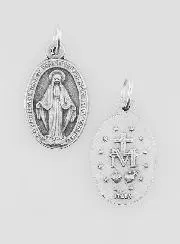The Miraculous Medal, also known as the "Rue du Bac Medal", holds a special place in the hearts of believers the world over. Its story began in 1830, when Catherine Labouré, then a novice with the Daughters of Charity in Paris, had an apparition of the Virgin Mary. She asked her to have a medal struck, promising graces to those who wore it with faith. Since then, the Miraculous Medal has become a universal symbol of hope and devotion. Let's find out how it is venerated and celebrated in different countries and cultures.
The Story of the Miraculous Medal : A reminder of faith and hope
The story of the Miraculous Medal dates back to 27 November 1830, when the Virgin Mary is said to have appeared to Catherine Labouré, a nun in the chapel of the Daughters of Charity on rue du Bac in Paris. The Virgin was said to have instructed her to have a medal engraved with symbols of protection and grace, promising blessings to those who wore it. It was given the name "miraculous" because of the many miracles and cures attributed to her intercession. The medal's design, consisting of the image of Mary surrounded by the words "O Mary conceived without sin, pray for us who have recourse to you", and an M surmounted by a cross on the reverse, symbolises the devotion of Catholics to the Immaculate Conception and their trust in divine protection.
The Miraculous Medal in Europe: a strong and deep-rooted devotion
In Europe, France is naturally at the heart of devotion to the Miraculous Medal. The chapel on rue du Bac, where Catherine Labouré had her visions, attracts thousands of pilgrims every year, who come to pray and receive the medal. They hope for cures, spiritual help or comfort. In Italy, the Miraculous Medal is also very popular. Many Italians wear it as a protective talisman. It is often given to children and young people as a sign of faith and to ask for Mary's blessing on their lives. In countries such as Spain and Portugal, where Catholicism plays an important role, prayer groups are dedicated to spreading the Miraculous Medal. Annual celebrations are organised, particularly during the feast of the Immaculate Conception in December.
The Miraculous Medal in America: a symbol of faith and resilience
In Latin America, the Miraculous Medal is often integrated into local traditions and worn with fervour. In Argentina, Mexico and Brazil, it is widespread among Catholic families. It is seen as a sign of hope in difficult times and is often worn during prayers for health and protection. In the United States, the Miraculous Medal is also very popular, particularly in the Catholic community. As a result of waves of Catholic immigration in the 19th century, the medal has become an important symbol of religious identity for many Americans. Churches and devotional centres, such as the National Shrine of the Miraculous Medal in Missouri, hold annual events to honour the Virgin and encourage believers to pray for her graces.
The Miraculous Medal in Asia: adaptation and tradition
In Asia, devotion to the Miraculous Medal took root thanks to the Catholic missions. In the Philippines, where Catholicism is the majority religion, the Miraculous Medal is worn by many of the faithful who see it as protection against misfortune and disease. Churches regularly organise processions and masses dedicated to the Virgin of the Miraculous Medal. In Japan, although Catholics are in the minority, Christian communities use the Miraculous Medal as a link with their brothers and sisters in faith around the world. In a country where Catholicism has been persecuted for centuries, this medal has become a discreet and personal symbol of faith.
In Africa: a talisman of protection and grace
In Africa, the Miraculous Medal is also venerated in many countries. In Côte d'Ivoire, Benin and Nigeria, it is often worn as a protective talisman. It is an integral part of local customs, and even non-Christians sometimes see it as an object of goodwill. Priests and sisters in local communities distribute the medal at baptism and confirmation ceremonies as a special blessing.
The Miraculous Medal's universal message
The Miraculous Medal's popularity around the world testifies to its universal message of peace, healing and grace. It transcends cultural and linguistic boundaries, adapting to different local customs while retaining its spiritual essence. The Miraculous Medal is therefore much more than a simple object of faith: it is a symbol of love and protection for those who wear it. Across continents and cultures, it unites believers under the sign of Mary's mercy, offering support to all in their daily challenges.
The worldwide devotion to the Miraculous Medal illustrates how a religious symbol can transcend borders and bring individuals together in a common quest for faith and inner peace. Whether in Paris, Mexico City, Manila or elsewhere, the Virgin of the Miraculous Medal continues to inspire millions of people around the world.




















